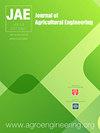果园农业辅助机器人自动行走——RTK-GNSS有效性验证及规格设计模拟器开发
IF 2.4
4区 农林科学
Q2 AGRICULTURAL ENGINEERING
引用次数: 0
摘要
劳动力短缺和农业工作中的致命事故最近成为日本的关键问题,需要提高生产力、减少工作量和确保安全。因此,在日本和具有类似农业环境的国家,使用小型和廉价的农业机器人,可以在山地农场和果园使用是可取的。为了验证全球导航卫星系统(GNSS)和实时运动学(RTK)-GNSS的定位精度和稳定性,本研究在山区果园进行了动态定位试验。此外,开发了可考虑果园环境信息的农业机器人模拟器,并利用模拟中获取的GNSS数据进行了驾驶测试。将GNSS模块的误差设置为高于实测值的误差,模拟机器人在果园中的行走。在山区附近果园进行的GNSS定位试验结果表明,在特定的环境条件下,RTK-GNSS和单机(SA)-GNSS的定位精度分别可以达到几十厘米和几米的数量级。此外,基于GNSS定位结果的仿真结果表明,采用RTK-GNSS和简单障碍物检测传感器的车辆可以在农家院中自主行驶,而不会与树行发生碰撞。相比之下,采用SA-GNSS和简单障碍物检测传感器的车辆无法在果园中自主行驶,必须使用更精确的传感器实现自我定位。因此,本文提出的基于真实果园GNSS数据实现自主农业机器人仿真的方法,有助于对实际农业机器人进行评估,确认安全行驶。研究结果表明,开发果园小型农业机器人是可行的。我们在海拔约830m的果园中进行了GNSS定位测试,在类似的农业情况下,由于在驾驶模拟测试中设置了GNSS模块的误差高于实测值,因此可以预期具有类似的性能。本文章由计算机程序翻译,如有差异,请以英文原文为准。
Automatic travelling of agricultural support robot for a fruit farm -Verification of effectiveness of RTK-GNSS and developed simulator for specification design
Labour shortages and fatal accidents in agricultural work have recently emerged as critical problems in Japan, necessitating productivity enhancement, workload reduction, and safety assurance. Therefore, in Japan and countries with similar agricultural environments, the use of small and inexpensive agricultural robots that can be used in mountain farms and orchards is desirable. In this study, a dynamic positioning test was performed in orchards in a mountainous region to verify the positioning accuracy and stability of the Global Navigation Satellite System (GNSS) and real time kinematic (RTK)-GNSS. In addition, a simulator for an agricultural robot that could consider the environmental information of orchards was developed, and driving tests were conducted using the GNSS data acquired in the simulation. The error of the GNSS module was set to be higher than that for the measured value, and robot travelling in the orchard was simulated. The results of GNSS positioning tests in an orchard near a mountainous area indicate that in the specific environmental conditions, the RTK-GNSS and stand-alone (SA)-GNSS can attain a positioning accuracy with an order of tens of centimetres and few metres, respectively. Moreover, the simulation results based on the GNSS positioning results indicate that a vehicle implementing RTK-GNSS and a simple obstacle detection sensor can travel autonomously in a farmyard without colliding with the tree rows. In contrast, a vehicle implementing SA-GNSS and a simple obstacle detection sensor cannot drive autonomously in an orchard and must realise self-positioning using a more accurate sensor. Therefore, the proposed approach of realising simulations of autonomous agricultural robots based on GNSS data from a real orchard can facilitate the evaluation of practical agricultural robots and confirming safety traveling root. The results demonstrate the possibility of development of small agricultural robot for orchards. We conducted the GNSS positioning test in an orchard at an altitude of approximately 830 m, and a similar performance can be expected under similar agricultural situations because the error of the GNSS module was set to be higher than the measured value in driving simulation test.
求助全文
通过发布文献求助,成功后即可免费获取论文全文。
去求助
来源期刊

Journal of Agricultural Engineering
AGRICULTURAL ENGINEERING-
CiteScore
2.30
自引率
5.60%
发文量
40
审稿时长
10 weeks
期刊介绍:
The Journal of Agricultural Engineering (JAE) is the official journal of the Italian Society of Agricultural Engineering supported by University of Bologna, Italy. The subject matter covers a complete and interdisciplinary range of research in engineering for agriculture and biosystems.
 求助内容:
求助内容: 应助结果提醒方式:
应助结果提醒方式:


